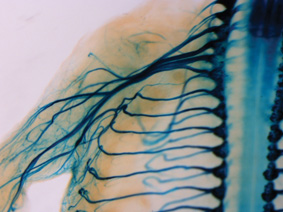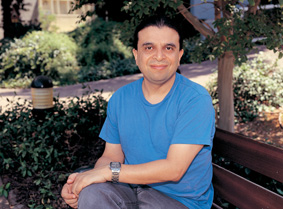How do nerve fibers develop and reach their goals without making mistakes along the way?

A complex system of nerve fibers connects more than 100 billion brain cells among themselves and the brain cells to the peripheral nervous system and muscles. These nerve fibers, called "axons", can sometimes grow to a length of a meter, and in the process, on their way to their destination, they have to make their way through the surrounding tissues while overcoming many obstacles. How do the axons manage to get to the right place with such great precision without losing their way?
Dr. Avraham Yaron, from the Department of Biological Chemistry in the Faculty of Biochemistry of the Weizmann Institute of Science, is trying to clarify the mechanisms that ensure the correct connection of the billions of nerve cells during the development of the nervous system in the fetus. Understanding these processes may contribute to the future development of ways to treat nerve defects or injuries that damage the nerves.
In the last decade it became clear that axons navigate to their targets using a kind of "GPS system", which instead of satellites is based on chemical signals. These signals can act in two ways to ensure that the axons do move in the right direction: they can attract the axons to the target, or repel them, i.e. function as a kind of "barriers" that prevent the axons from turning in wrong directions. Scientists have already described several families of major "guidance" molecules, which apparently work in different ways. But still very little is known about the mechanisms of action of this branched chemical system.
Yaron's research focuses mainly on the "guidance" of sensory axons, which transmit sensations of pain, heat and touch from the skin to the brain. These axons are guided by a family of guidance proteins called semphorins. But just like in the GPS system, the axons also need an "input unit" to receive the guidance signals. This unit consists of protein receptors displayed on the membranes of the axons.
In his post-doctoral research, Dr. Yaron discovered two receptors from the plexin family, which are located on the axons and mediate the transmission of the semaphorins' signal. In the research he is currently conducting at the Weizmann Institute of Science, Dr. Yaron aims to find out exactly how the signals are transmitted through these receptors. He is also trying to identify new guidance molecules, and find out how all these signals connect together.
For this purpose, he uses two complementary methods: experiments in cell cultures, in which the scientists expose the axons to various guidance signals and monitor the results, and experiments in laboratory mice, in which the results are confirmed and additional factors are tested to analyze the behavior of the axons in a complex and "real" environment. .
Meanwhile, according to the preliminary results, it seems that the guidance proteins from the semphorin family work through the plexin receptors to transmit the rejection signals. Thus, in the presence of the receptor, the developing axons are prevented from turning in wrong directions, and advance on the correct path to the target. On the other hand, when the scientists disrupt the receptor gene, thus removing the "barrier" in the way, the axon gets lost and grows in the wrong directions.
In another study, the members of Dr. Yaron's research group focus on nerve damage that sometimes accompanies diabetes. In diabetic patients, and also in cancer patients receiving chemotherapy treatment, sensory axons may detach from their target, which causes severe pain in the limbs. Yaron is trying to find out whether the developmental guidance molecules play any role in these pathological conditions. If it turns out that they do have such a role, it may be possible to develop innovative treatment methods that will make it easier for patients with these diseases.
Recently, evidence has also been found that chemical guidance signals play a role in many other processes besides axon guidance. Among other things, these are the processes of the development of new blood vessels, and the migration of cells of the immune system and cancer cells that set out to establish cancer metastases. Understanding the mechanisms of action of guidance molecules may, therefore, help in the development of treatments for additional diseases.

Dr. Avraham Yaron was born in Jerusalem, and received his first degree in biology from the Hebrew University of Jerusalem in 1993. He continued on a direct path to a doctorate in the Department of Immunology of the School of Medicine of the Hebrew and Hadassah University, and received his doctorate in 1999. "I was already interested in science as a child, but It was only during my doctoral studies that I decided that I really wanted to be a scientist," he says. His doctoral thesis earned him the 2000 Amersham/Pharmacia Biotech Award, which is given by the scientific journal Science to young scientists. He did post-doctoral research in the laboratory of Prof. Marc Tessier-Levin at the University of California, San Francisco, where he was first exposed to research on axon guidance and discovered the plexin receptors. In 2006 he joined the Weizmann Institute of Science as a senior researcher.
